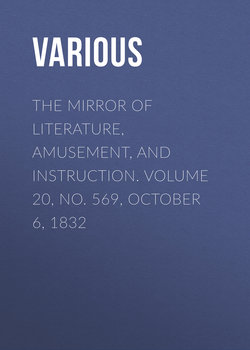The Mirror of Literature, Amusement, and Instruction. Volume 20, No. 569, October 6, 1832

Реклама. ООО «ЛитРес», ИНН: 7719571260.
Оглавление
Various. The Mirror of Literature, Amusement, and Instruction. Volume 20, No. 569, October 6, 1832
LISBON
MRS. HEMANS
SPONTANEOUS COMBUSTION
RETROSPECTIVE GLEANINGS
EARLY PARLIAMENTS
MANNERS AND CUSTOMS
MARVELLOUS CURE OF THE TOOTHACH
JOURNAL OF A SHERIFF OF LONDON
THE NATURALIST
THE NIGHTINGALE
NOTES
THE STORK
FINE ARTS
THE GRAVE OF TITIAN
HOSPITAL OF ST. CROSS, HANTS
THE PUBLIC JOURNALS
SCRAPS FROM THE DIARY OF A TRAVELLER
ON THE DEATH OF SIR WALTER SCOTT
TO A ROSE
NEW BOOKS
NUMISMATICS
THE GATHERER
THE LATE SIR. WALTER SCOTT, BART
Отрывок из книги
Lisbon, the capital of Portugal, was called by the ancients Ulyssippo, and the foundation is fabulously ascribed to Ulysses. The situation is grand, on the north bank of the river Tagus, in lat. 38° 42-1/3′ N., lon. 9° 8-1/3′ W. The harbour, or rather road, of Lisbon, is one of the finest in the world; and the quays are at once convenient and beautiful. On entering the river, and passing the forts of St. Julian and of Bugio, situated respectively at the extremities of the northern and southern shores, we obtain a view of Lisbon crowning the hills on the north bank, about three leagues distant above the mouth of the Tagus. The quintas or villas scattered over the country, between the villages, become more numerous the further we advance; till, at length, on approaching Belem, an uninterrupted chain of edifices is seen extending along the margin of the noble river, to the remotest part of the ancient capital, being a distance of full six miles. Opposite Belem Castle, and on the southern shore of the Tagus, is the small fort of Torre Velha. These two forts, situated at the narrowest part of the river, guard the approach to the capital by sea; and all vessels arriving at its port have their papers examined at Belem Castle. The salutes of ships of war are, in like manner, answered by its guns. Proceeding onward, we pass the Convent of St. Geronymo, a splendid pile of Moorish architecture, "the picturesque appearance of the scene being heightened by groups of boats peculiar in their construction to the Tagus." From Belem we trace a range of buildings, connecting it with Alcantara and Buenos Ayres, and finally with the ancient city of Lisbon. Alcantara is situated at the mouth of a narrow valley opening upon the Tagus. Upon the brow of the hill, on the eastern side, is another of the royal residences, called the palace of Necessiades; and, stretching across the valley, about a mile above this point, is the far-famed aqueduct, which conveys the chief supply of water to the capital. The new and populous quarter of Buenos Ayres (so called from its being considered the healthiest situation around the capital,) covers the steep hills situated in the angle formed by the Alcantara valley and the Tagus. Miss Baillie, in her amusing Letters, describes Buenos Ayres as "a suburb of Lisbon, standing upon higher ground than the city itself, and a favourite resort of the English, being generally considered as a cooler and more cleanly (or rather a less filthy) situation than the latter." The splendid river scenery from Belem to Lisbon, the luxuriant prospect from the adjoining heights; the city itself, with its domes, and towers, and gorgeous buildings—all this proud assemblage of nature and art—remind us that
The Engraving represents one of the most comprehensive views of the city, obtained from an eminence crowned by the chapel of Nossa Senhora da Monte. It has been copied from one of Colonel Batty's faithful Views,1 and its details cannot better be explained than in the words of the clever artist:
.....
It was contrary to an ancient rule of the constitution, that any person should be allowed to vote at elections who did not reside in the place or county where the election was made; that rule says, that "ineddem comitata commercentes et residentes" only shall vote; and this was confirmed by an act of parliament, (1 Henry V. c. i.) but recently repealed.
In 1429, an important change was made as to the qualifications of the voters for knights of the shires. The voters were obliged to prove themselves worth 40s. per annum. Before this time, every freeholder might vote, and the vast concourse of electors brought on riots and murders. Seventy pounds would, in modern days, be barely an equivalent for our ancestors' 40s. The freeholders were, at the same time, directed to choose two of the fittest and most discreet knights resident in their county; or, if none could be found, notable esquires, gentlemen by birth, and qualified to be made knights; but no yeoman or persons of inferior rank.
.....